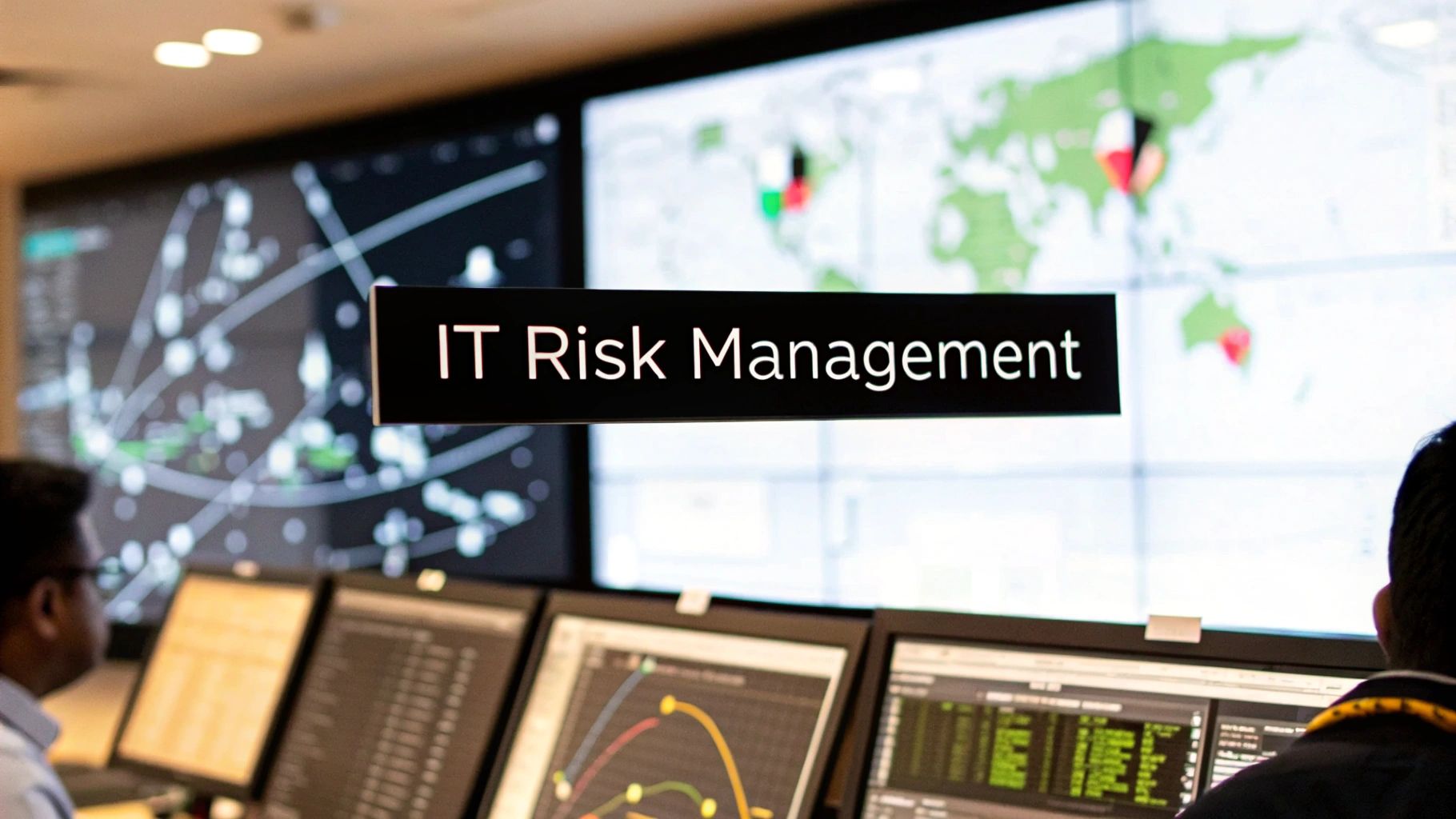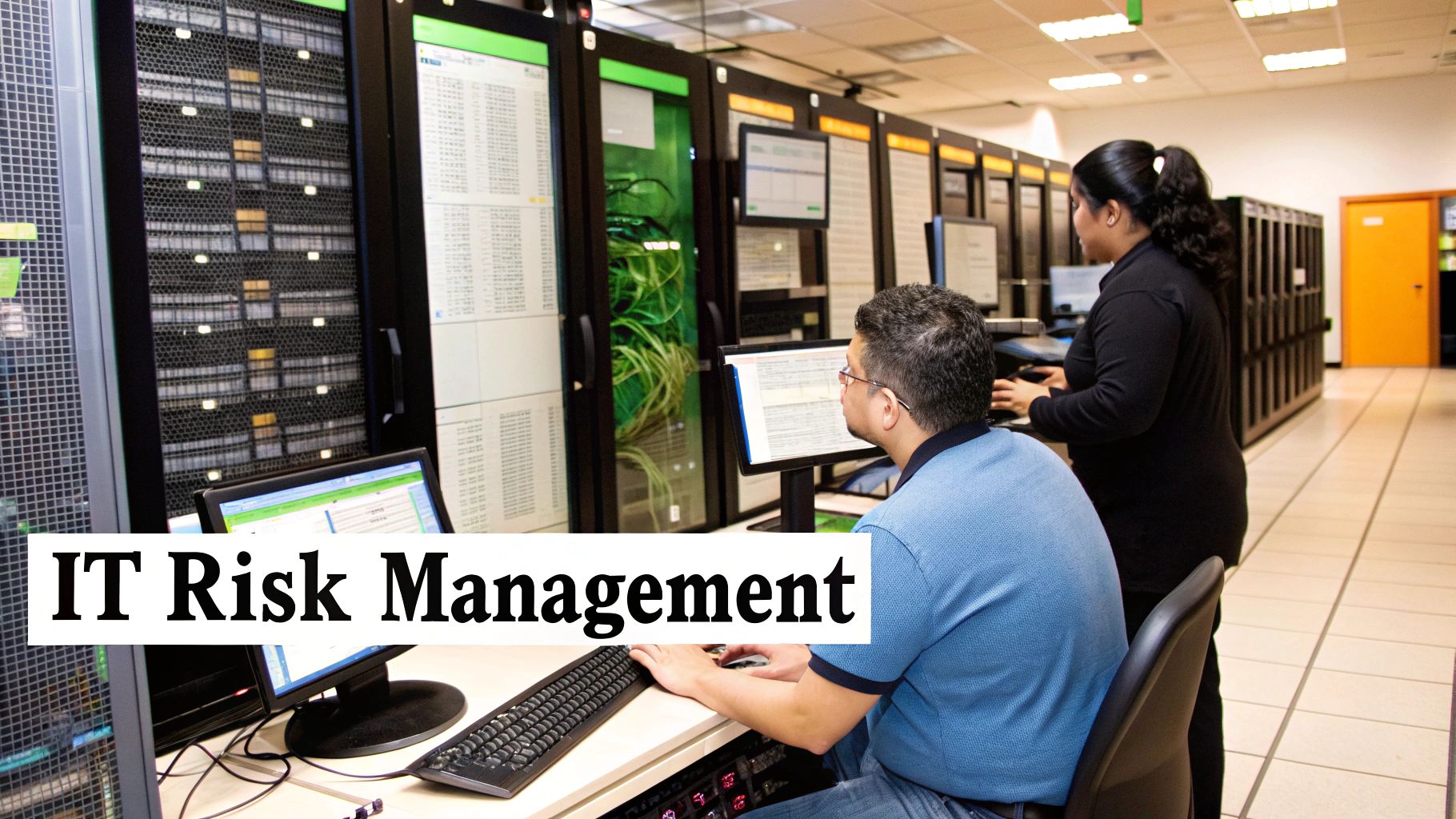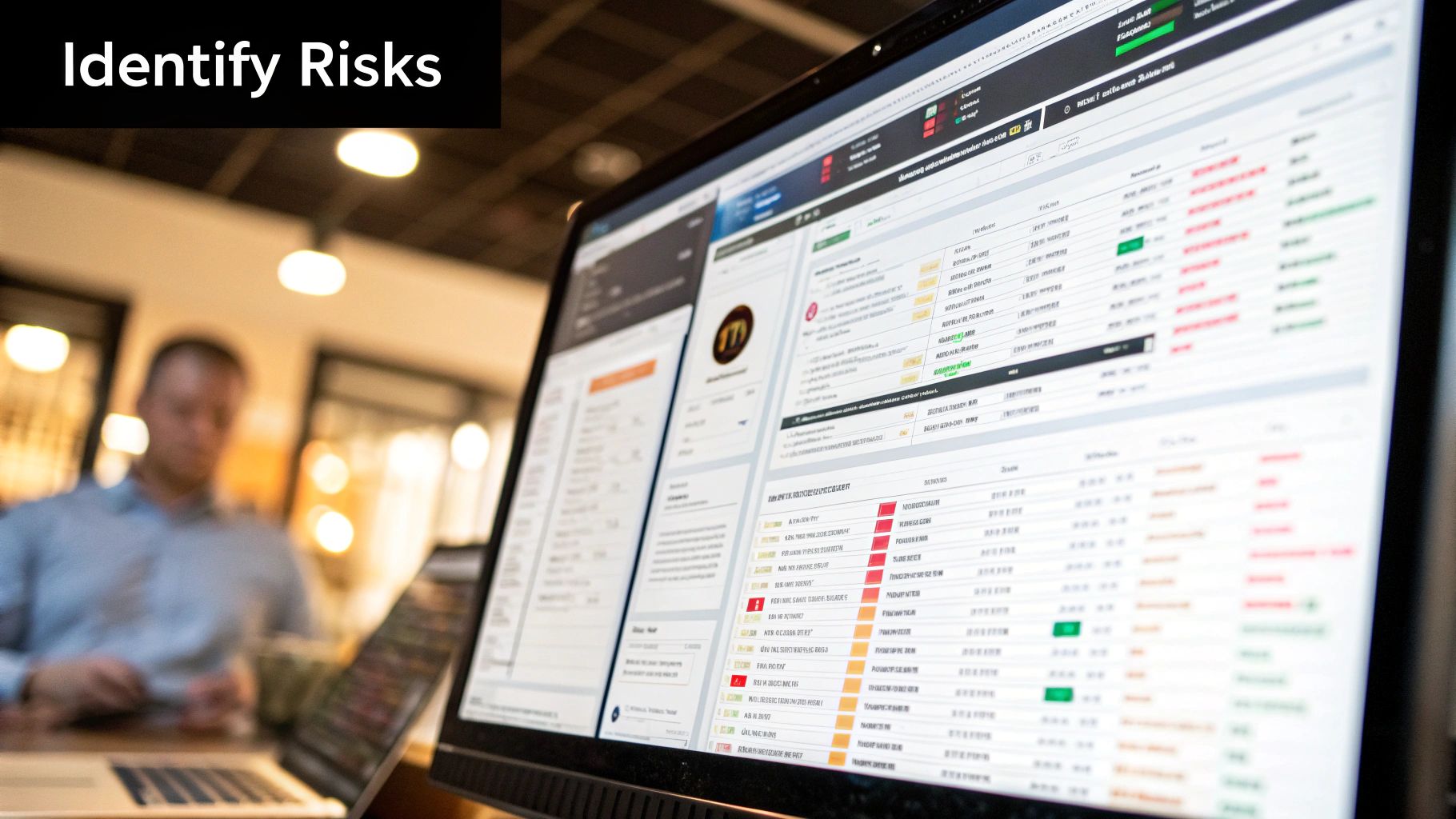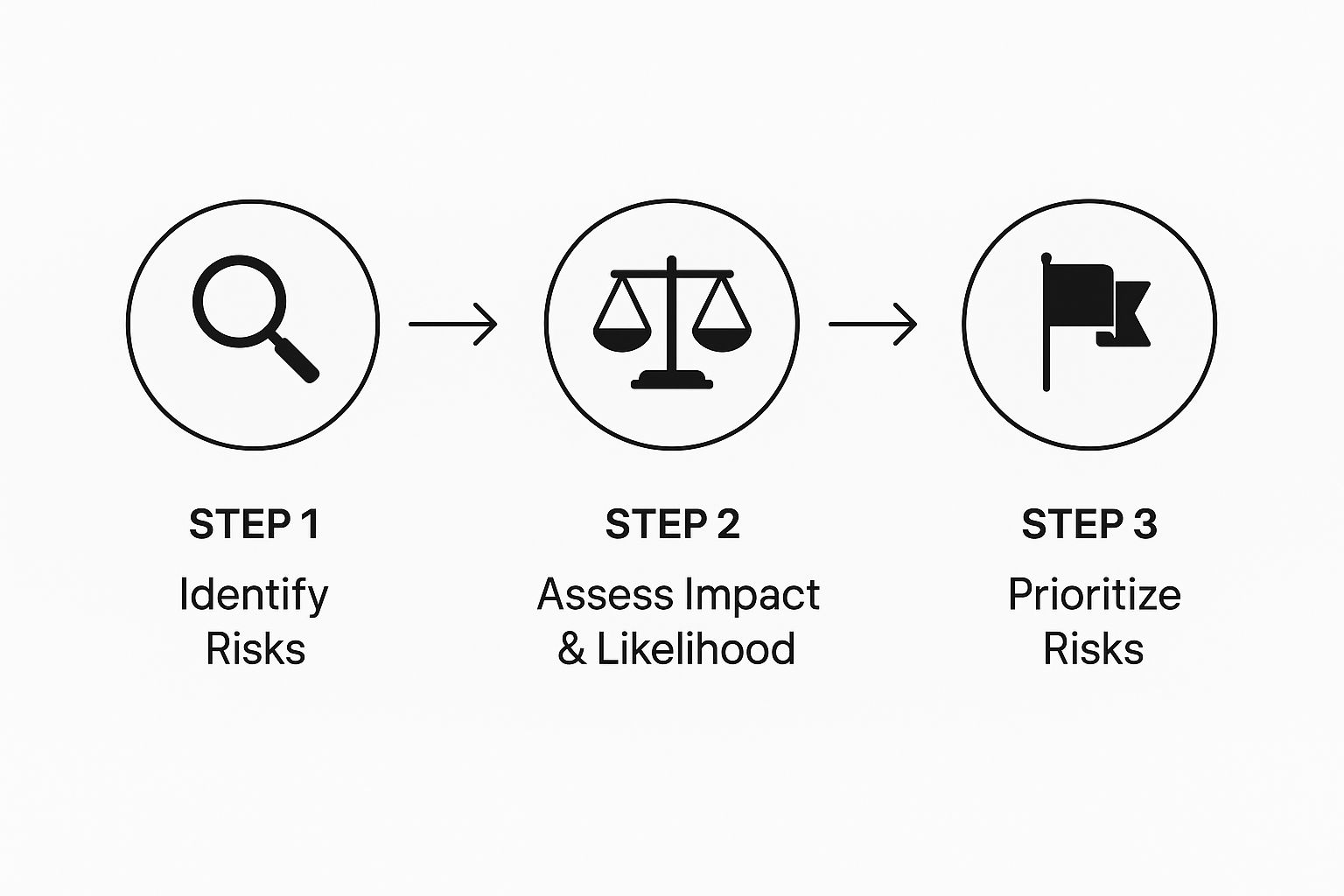
Information Technology Risk Management: A Modern Guide
Information technology risk management is the game plan for spotting, evaluating, and neutralizing potential threats to your company's tech infrastructure and data. It’s all about creating a business that’s tough enough to handle digital surprises, especially with new rules like the EU AI Act changing the playing field for artificial intelligence governance.
Why IT Risk Management Is Now a Business Strategy

IT risk management has officially moved out of the server room and into the boardroom. It's no longer a simple to-do list for the tech team; it's a core piece of how smart businesses operate today.
Think of it this way: a ship's captain doesn't just react to storms as they appear. They use sophisticated weather models and navigation charts to plot a course that avoids the worst of it, ensuring they reach their destination safely and efficiently. In the business world, proactive risk management works the same way—it's not just about avoiding disaster, it's about enabling success.
The Shift from Defense to Offense
For years, IT risk was purely defensive. It was all about putting up firewalls, running antivirus scans, and making sure backups were working. Those things are still absolutely essential, but the bigger conversation has shifted. A solid information technology risk management program is now about building an organization that can confidently jump on new opportunities without getting knocked over by the unexpected.
This change didn't happen in a vacuum. A few key forces are at play:
- Complex Regulations: New laws, especially the EU AI Act, place serious risk management responsibilities on companies developing or using artificial intelligence. Compliance is no longer optional; it's a central business function with significant legal weight.
- Interconnected Systems: We're all linked together now. A single weak point in a vendor's software can send shockwaves through your own operations.
- Reputation and Trust: A data breach or a major system outage can shatter customer trust in an instant. In a world of social media and 24/7 news, that kind of damage can be permanent.
When you get ahead of these issues, risk management stops being a cost center and starts becoming a competitive edge. It gives you the freedom to innovate responsibly while protecting your assets and reputation.
A Data-Driven Approach to Risk
The best strategies today are built on data and focused on results. Instead of just ticking boxes on a compliance checklist, leading companies are using financial quantification frameworks to put a real number on their risk. Research from the FAIR Institute highlights how this move helps risk professionals make a clear business case for security investments and tackle threats before they materialize. You can explore the full research about modern outcome-oriented approaches to see how it works.
By framing IT risks in the language of business—dollars and cents, operational impact, and strategic goals—leaders can make smarter, more informed decisions that drive growth and ensure long-term stability.
At the end of the day, managing technology risk isn't just about preventing losses. It’s about building a solid foundation that allows your company to chase its goals with confidence, knowing you’re ready for whatever digital challenges or regulatory changes like the EU AI Act come your way. It's become an essential part of strategic decision-making.
Choosing Your IT Risk Management Framework

Once you’ve accepted that risk management is a core part of your strategy, the next question is, "How do we actually do it?" This is where a solid information technology risk management framework comes in. It provides the blueprint—the common language and proven processes—you need to build a consistent, effective program.
Trying to manage IT risk without a framework is like building a house without architectural plans. Your efforts will be disorganized, reactive, and almost impossible to measure. These established models give you a structured path to follow, guiding you from identifying threats to implementing controls. The goal isn't to find a magic bullet, but to choose the right architecture for your company's specific size, industry, and regulatory pressures, including those mandated by the EU AI Act.
Understanding The Core Philosophies
Different frameworks were born from different needs, and they each have a distinct personality. Some are designed for flexibility and continuous improvement, while others provide a more rigid, certifiable structure. Let's dig into the three most respected frameworks in the field.
NIST Cybersecurity Framework (CSF)
Think of the NIST CSF as less of a strict rulebook and more of a practical guide. Developed by the U.S. National Institute of Standards and Technology, its main goal is to help organizations—especially those in critical infrastructure—get a better handle on their cybersecurity. It’s built around five simple, powerful functions: Identify, Protect, Detect, Respond, and Recover.
This structure makes it incredibly adaptable. A small startup can use its core ideas to cover the basics, while a global corporation can use it to build a deeply layered security program. Its popularity comes from this flexibility and its use of plain language, which is a huge help when trying to get technical teams and the C-suite on the same page.
ISO/IEC 27001
Where NIST is flexible, ISO/IEC 27001 is formal. It's an official standard for creating an Information Security Management System (ISMS). This framework is all about process, documentation, and a cycle of continuous improvement. The end goal is often an official certification that you can show to clients and regulators as proof of your commitment.
Getting ISO 27001 certified is no small feat. It requires you to meticulously document your risk assessments, treatment plans, and controls. It has become the gold standard for companies that need to formally prove their security chops, particularly those operating internationally or handling very sensitive data. You can learn more about how these frameworks fit into a bigger picture in our deep dive on governance, compliance, and risk.
COBIT (Control Objectives for Information and Related Technologies)
COBIT zooms out to offer a much broader view, focusing on the overall governance and management of enterprise IT. While NIST and ISO are laser-focused on security, COBIT’s mission is to align IT with the company’s business objectives. It helps ensure that technology isn't just secure, but that it's actually delivering value and pushing strategic goals forward.
This framework is a natural fit for large, complex organizations that need to manage IT governance from the top down. It provides the tools to connect risk management directly to stakeholder needs and core business processes, ensuring your entire IT operation is effective, secure, and fully aligned with your mission.
A Head-to-Head Comparison
To pick the right path, you need to understand how these frameworks differ at their core. The decision really boils down to your organization's priorities—are you looking for a flexible guide, a certifiable system, or a comprehensive governance model?
This table breaks down the key distinctions to help you decide.
Comparing Leading IT Risk Management Frameworks
| Framework | Primary Focus | Best For | Key Components |
|---|---|---|---|
| NIST CSF | Improving cybersecurity resilience and communication | U.S. federal agencies, critical infrastructure, and organizations seeking a flexible, risk-based approach | The Core (Functions, Categories, Subcategories), Implementation Tiers, and Profiles |
| ISO/IEC 27001 | Establishing, implementing, and improving a certifiable Information Security Management System (ISMS) | Organizations needing formal certification to prove security posture to clients, partners, and regulators | Risk assessment and treatment, Annex A controls, statement of applicability, and continuous improvement cycle |
| COBIT | Governance and management of enterprise IT to align with business goals | Large enterprises requiring a top-down governance model that links IT processes and risk to business objectives | Governance and Management Objectives, Design Factors, and a detailed Process Reference Model |
It’s important to remember that these frameworks aren't mutually exclusive. In fact, many organizations create a hybrid model. They might use the NIST CSF for day-to-day operational guidance, pursue ISO 27001 for certification, and lean on COBIT for high-level governance. The right choice—or combination—will give you the structure needed to turn your information technology risk management strategy into a real-world success.
Building Your Risk Management Program Step-by-Step
A good framework gives you the blueprint, but it's up to you to actually build the house. Constructing a solid information technology risk management program isn't a one-and-done project; it's a continuous cycle. Think of it as an active, repeatable process that helps you methodically figure out what could go wrong, understand the potential fallout, and make smart decisions on how to handle it.
This lifecycle turns abstract ideas into concrete actions. Each step logically flows into the next, creating a structured approach that shifts your organization from a reactive, fire-fighting mode to a proactive, strategic one. Let's walk through this process, breaking down each phase with some real-world examples.
Step 1: Identify Your Risks
You can't manage a risk you don't even know exists. The first, and arguably most important, step is a thorough discovery process to create a comprehensive list of potential threats to your IT environment. It’s like surveying the land before you lay a foundation—you need to map out every possible hazard, from the obvious sinkholes to the hidden fault lines.
And this isn't just a job for the IT department. To get this right, you have to involve people from across the entire organization.
Here are a few proven techniques to get you started:
- Brainstorming Sessions: Get leaders from different departments—IT, legal, finance, operations—in a room to talk about potential threats from their unique viewpoints. What keeps the head of finance up at night will be different from the CISO's top concern.
- Vulnerability Scanning: Use automated tools to sweep your networks, applications, and systems for known security weaknesses. This is your digital inspection.
- Reviewing Past Incidents: Look back at previous security incidents or system failures, both within your own company and across your industry. What went wrong, and what's to stop it from happening again?
- Threat Intelligence Feeds: Subscribe to services that provide real-time information on emerging cyber threats, new attack methods, and critical vulnerabilities.
For example, a company developing a high-risk AI system under the EU AI Act must identify specific risks like algorithmic bias leading to discriminatory hiring practices, poor data governance causing major privacy breaches, or a "black box" model that violates transparency requirements and fundamental rights.
This initial step is absolutely foundational. The goal is to cast a wide net and capture every plausible risk, creating a master list often called a risk register. This document becomes the central nervous system for your entire program.
This infographic shows how the process flows from initial discovery to sorting out the threats.

As you can see, a successful program starts with a methodical approach to identifying and assessing threats before you can prioritize what really matters.
Step 2: Analyze and Evaluate Risks
Once you have your risk register, the next move is to analyze each threat. Let's be honest, not all risks are created equal. A minor server outage is an annoyance, but a catastrophic data breach could put you out of business. This phase is all about adding context to your list by figuring out two key things for each risk: likelihood (how probable is it?) and impact (how bad would it be?).
By combining likelihood and impact, you create a risk score. This simple metric transforms a long, overwhelming list of potential problems into a prioritized action plan.
For instance, the likelihood of a key employee clicking on a sophisticated phishing email might be high. The impact, however, could range from moderate (a single compromised account) to severe (a full-blown ransomware attack that shuts down operations). The idea is to assign a score—often on a simple scale of 1 to 5 or using a high/medium/low classification—to every risk. This evaluation immediately shows you which fires to put out first and which ones you just need to keep an eye on.
Step 3: Treat the Identified Risks
With your risks analyzed and prioritized, it's time to decide what to do about them. Risk treatment isn’t always about elimination; it's about choosing the most strategic and cost-effective response. You generally have four main options.
- Avoid: Sometimes, the best move is to avoid the risk entirely by stopping the activity that creates it. If a legacy software system is riddled with holes and too expensive to secure, you might just decommission it instead of pouring money into patching it.
- Accept: Certain risks just aren't worth the cost of fixing. If the potential impact of a threat is low and the resources required to mitigate it are high, you might make a formal decision to accept the risk and focus your efforts elsewhere.
- Transfer: This strategy involves shifting the financial burden of a risk to someone else. The most common example is buying cybersecurity insurance to cover the massive costs associated with a data breach.
- Mitigate: This is the most common approach. Mitigation means implementing controls to reduce either the likelihood of a risk happening or the impact if it does. This could be anything from installing new security software and enforcing stronger password policies to running regular employee security training.
The right choice here really depends on your organization's risk appetite—that is, the amount of risk it's willing to take on to achieve its goals.
Step 4: Monitor and Review Continuously
Finally, and this is critical, information technology risk management is never "done." The threat landscape, your technology stack, and your business goals are all in a constant state of flux. Because of this, your risk program has to be a living, breathing process.
This means regularly circling back to your risk register, reassessing your risk scores, and checking if your controls are actually working as intended. Continuous monitoring ensures your program stays relevant and effective, helping you get ahead of new challenges—like emerging AI regulations and evolving cyber threats—before they turn into major crises.
Confronting Today’s Most Dangerous Cyber Threats

The world of digital threats is no longer just persistent—it’s smart, adaptive, and relentlessly searching for the next weak spot. A solid information technology risk management program has to cut through the noise of generic warnings and zero in on the specific, high-impact threats that could actually shut a business down. Getting a handle on these real dangers is the first, most critical step toward building a defense that works.
Forget the simple viruses of the past. Today's attacks are sophisticated campaigns, often waged with the patience and resources you'd expect from a government agency. Understanding this context is crucial; it’s why a proactive, intelligence-led defense isn't just a good idea, it's a matter of survival.
Ransomware as a Business Model
Ransomware has morphed from a simple file-locking nuisance into a full-blown criminal enterprise. Attackers aren't just encrypting your data anymore; they're stealing it first. This is the "double extortion" tactic, and it adds a whole new level of pressure. If you don't pay up to unlock your systems, they threaten to leak your most sensitive company secrets or customer data online.
For companies in the AI space, this hits particularly hard. The proprietary data used to train your models is often your most valuable asset. A ransomware attack that siphons off that data isn't just an operational headache—it's the theft of your core intellectual property. That's a devastating business risk.
The Hidden Dangers in Your Supply Chain
Your security is only as strong as its weakest link, and that link is often a vendor or partner you trust. Software supply chain attacks are becoming disturbingly common. Attackers compromise a single, trusted third-party tool and use it to push malware to all of its customers. Why attack one company when you can hit thousands at once?
Think of it like a contaminated ingredient getting into a food factory. That single bad component spreads through the entire distribution network before anyone even knows something is wrong.
The World Economic Forum's Global Cybersecurity Outlook 2025 paints a stark picture of the threats we're up against. Ransomware still tops the list of concerns, with 45% of organizations ranking it as their number one risk. Right behind it is cyber-enabled fraud like phishing at 20%, followed by supply chain disruptions (17%) and insider threats (7%). You can dive deeper into these findings in the full cybersecurity outlook report.
These numbers make it clear: while ransomware grabs the headlines, the interconnected way we do business creates multiple failure points that all need careful management.
The Subtle Threat From Within
Not every threat is trying to break in from the outside. Insider threats—whether they’re malicious or just accidental—are a quiet but incredibly damaging risk. An employee with perfectly legitimate access to sensitive systems can cause a world of hurt if their credentials are stolen or if they decide to abuse their privileges.
Just picture a couple of scenarios:
- Accidental Exposure: An engineer unintentionally misconfigures a cloud server, leaving the training data for a new AI model wide open to the public internet.
- Malicious Intent: A disgruntled developer on their way out the door quietly slips a backdoor into the code of a high-risk AI system. This not only creates a future vulnerability but could also be a direct violation of regulations like the EU AI Act.
Incidents like these show why a comprehensive information technology risk management strategy has to look beyond just firewalls and antivirus. It demands a sharp incident response plan, good threat intelligence, and a company culture where everyone understands they play a role in security.
Integrating AI Risks and the EU AI Act
Artificial intelligence isn't just another software update. It brings a whole new class of risks to the table—risks that most traditional information technology risk management programs were never built to handle. For compliance officers and tech leaders, the world of AI is less about firewalls and more about fairness, transparency, and accountability.
These new challenges come from the very nature of AI itself. An AI model isn’t a static piece of code; it's a dynamic system that learns from data. That learning process can lead to some unexpected, and often problematic, outcomes. We're talking about everything from algorithmic bias creeping into hiring tools to data privacy breaches in customer-facing apps. The core problem? You can't always predict how an AI will behave once it's out in the wild.
This creates a massive governance gap. Old-school risk assessments that hunt for known software bugs just don't cut it anymore. Instead, we have to evaluate risks tied to the training data, the logic of the algorithm itself, and the real-world impact of the model's decisions.
A New Regulatory Reality: The EU AI Act
Regulators are moving fast to close this gap, and no piece of legislation is more important than the EU AI Act. Don't make the mistake of thinking this is just a European issue. It has a global reach, affecting any company offering AI systems to users inside the EU. Its arrival marks a huge shift, making risk management a non-negotiable legal duty for AI developers and deployers.
The Act lays out a clear, risk-based approach. Think of it like a pyramid, with the most dangerous AI applications at the top getting the most intense scrutiny.
- Unacceptable Risk: These AI systems are flat-out banned because they pose a clear threat to our fundamental rights. This includes things like government-run social scoring or tech that manipulates people by exploiting their vulnerabilities.
- High-Risk: This is where the real regulatory weight falls. High-risk systems are used in critical areas like medical devices, hiring, law enforcement, or managing essential infrastructure. They face a mountain of strict requirements before they can even hit the market.
- Limited Risk: Systems like chatbots fall here. They mainly have to meet basic transparency rules, like making it crystal clear to users that they're interacting with an AI, not a person.
- Minimal Risk: This covers the overwhelming majority of AI applications—think AI-powered spam filters or video games—which are mostly free from any extra regulation.
This risk-based framework is central to the Act's purpose: ensuring that AI innovation can flourish while protecting citizens from the most significant potential harms.
Your New Compliance Duties for High-Risk AI
If your company develops or uses a high-risk AI system, the EU AI Act saddles you with specific and demanding information technology risk management obligations. These aren't just suggestions; they are legal commands backed by the threat of staggering fines—up to €35 million or 7% of your company's annual global turnover.
The Act requires that a risk management system shall be established, implemented, documented and maintained in relation to high-risk AI systems. This is a continuous process that must cover the entire lifecycle of the AI system.
This means you are legally required to:
- Identify Foreseeable Risks: You have to systematically identify and analyze all known and reasonably foreseeable risks your AI could pose to people's health, safety, or fundamental rights.
- Estimate and Evaluate Risks: Once identified, you need to evaluate these risks, looking at both how bad the harm could be and how likely it is to happen. This includes risks that may emerge when the AI system is used as intended or under conditions of reasonably foreseeable misuse.
- Adopt Risk Management Measures: Next, you have to implement real, practical measures to deal with those risks. The goal is to eliminate or reduce risks as far as possible by design, followed by implementing adequate protection measures and, finally, providing users with clear information.
- Ensure Continuous Monitoring: This isn't a one-and-done task. You have to constantly monitor the AI’s performance out in the real world and update your risk assessments whenever new threats pop up. This is part of the mandatory post-market monitoring system.
Embedding AI Governance into Your Existing Program
The good news is you don't have to scrap your entire risk management framework. The goal is to augment it, beefing it up to handle the unique quirks of AI. This usually means creating a dedicated AI governance function that works hand-in-glove with your existing IT risk team.
For instance, your standard risk register now needs entries for AI-specific threats like model drift (where an AI’s accuracy degrades over time), data poisoning, and explainability issues. Your risk treatment plans must also evolve to include new mitigation tactics, like putting a "human-in-the-loop" for critical AI-driven decisions or conducting regular bias audits. Taking this kind of proactive approach is the only way to innovate responsibly while getting your organization ready for a future where AI regulation is the new normal.
Turning Your Risk Program into a Business Asset
An information technology risk management plan is only as good as its execution. If it just sits on a shelf collecting dust, it's worthless. For a risk program to truly work, it needs to become part of your company's DNA, and that boils down to two things: adoption and measurement.
Without real buy-in from leadership and a clear way to see if you're making progress, even the most brilliant framework is just a thought experiment.
The first major roadblock is always getting genuine support from the top. This means you have to stop talking in technical jargon and move past simple compliance checklists. You need to frame risk management for what it really is: a strategic tool that protects the bottom line, builds unbreakable customer trust, and gives leaders the confidence to make bold decisions. It’s a business asset, not just another expense.
But it’s not always easy. A staggering 87% of risk professionals admit their processes aren't widely accepted across their companies, which points to a huge cultural divide. Throw in the economic uncertainty that 73% of firms now see as their number one business risk, and it’s obvious that your approach has to be integrated and flexible. To dig deeper into these challenges, you can discover more insights about these risk management statistics.
Measuring What Truly Matters
If you want to show your program is working, you have to measure things that the business actually cares about. Forget just ticking boxes for compliance. The goal is to track tangible outcomes that show a real return on your efforts.
Instead of reporting on how many policies you’ve updated, start tracking key performance indicators (KPIs) that tell a compelling story about reduced risk and a more resilient organization.
- Reduced Incident Frequency: Are you seeing fewer security incidents over time? This is hard proof that your controls are working.
- Faster Detection and Response Times: How quickly can your team spot and shut down a threat? The faster you are, the less damage is done.
- Financial Impact of Mitigated Risks: This is the big one. Put a dollar amount on the potential losses you’ve prevented by closing specific security gaps. That’s a language every executive understands.
Creating a Risk-Aware Culture
At the end of the day, a strong risk program isn't just the security team's job—it's everyone's. When you embed a risk-aware mindset in every single department, your defenses are no longer siloed. They become a collective shield. This takes consistent training, open communication, and tools that make managing risk feel second nature.
A successful program makes everyone a risk manager. When employees understand their role in protecting the organization—from spotting a phishing email to following data handling policies—your entire security posture strengthens exponentially.
When you nail adoption and focus on meaningful metrics, your information technology risk management program changes. It stops being a cost center and becomes a clear business asset that doesn't just prevent disaster but actively enables growth, like the responsible rollout of new AI technologies.
Using specialized risk control software can be a game-changer here, helping to automate reporting and keep everyone in the loop, turning your program into the dynamic, strategic function it was always meant to be.
Got Questions? We've Got Answers.
As we wrap up, let's tackle a few common questions that pop up when people start putting information technology risk management into practice. These should clear up some key concepts and give you a solid footing.
What's the Real Difference Between IT Risk Management and Cybersecurity?
It’s easy to mix these two up, but they play very different roles.
Think of cybersecurity as the frontline defense—it's the digital equivalent of the security guards, armored trucks, and vault doors protecting a bank. Its job is highly tactical and technical, focused on stopping active threats like hackers, viruses, and data breaches.
Information technology risk management, on the other hand, is the bank's executive board and planning committee. It’s a strategic business function that takes a much wider view. It looks at the entire landscape of potential problems—cyber threats, yes, but also regulatory penalties, system failures, natural disasters, or even simple human error—and decides how much risk the organization is willing to accept to achieve its goals.
In short, cybersecurity protects the assets; risk management protects the business itself.
How Can a Small Business Get Started with IT Risk Management?
If you're a small business, don't feel like you need a massive, enterprise-grade program right out of the gate. The key is to start smart and focused.
First, figure out what your "crown jewels" are. Is it your customer database? Your e-commerce platform? Your proprietary source code? Identify the handful of digital assets that would cause the most damage if they were compromised.
Then, use a straightforward framework like the NIST CSF as a road map. You don't have to implement everything at once. Focus on the basics that deliver the most protection for your effort:
- Multi-factor authentication (MFA) on every single account. It’s one of the most effective controls you can implement.
- Reliable, tested data backups. Make sure you can actually restore your data when you need it.
- Regular security training for your team. Your people are your first line of defense, so make sure they know what to look for.
The goal isn't to become a fortress overnight. It's about making practical, intelligent decisions to manage your biggest threats without breaking the bank.
Does the EU AI Act Apply to My Company if We're Not in the EU?
Absolutely, and this is a critical point that many non-EU companies miss. The EU AI Act has what’s known as "extraterritorial scope," meaning its authority extends well beyond the borders of Europe.
If you offer a high-risk AI system to customers in the EU market—even if your company is based in California or Tokyo—you fall under its jurisdiction. This also applies if the output from your AI is used inside the EU.
Essentially, if European citizens can interact with your AI product, you'll almost certainly have to comply. That means meeting the Act's demanding requirements for risk management, data governance, and transparency, or else facing some truly eye-watering fines.
What Are the First Steps to Build an IT Risk Register?
Don't try to build your first risk register in an IT silo. It should be a collaborative effort from the very beginning.
Your first step is to get the right people in a room (or on a video call). Pull together a team with representatives from IT, legal, finance, and the main business departments. You need a 360-degree view of what could go wrong.
From there, just start brainstorming. Ask everyone to list potential risks that could derail their department's goals or the company's objectives. For every risk you identify, document three simple things: what might cause it, what the event would look like, and what the fallout would be. This simple list is the foundation of your risk register, which you'll later refine, analyze, and use to prioritize your actions.
Ready to ensure your AI systems are compliant and risk-free? ComplyACT AI guarantees compliance with the EU AI Act in just 30 minutes. Auto-classify your systems, generate technical documentation, and stay audit-ready with our user-friendly platform. Avoid the heavy fines and manage your AI risks with confidence by visiting https://complyactai.com today.